Review by Jeff Wilson, Michael Bettencourt, Steven Bochenek, Dan Heyman and Lesley Wimbush; photos by Jeff Wilson and Jonathan Yarkony
Originaly published September 16, 2013
2013 Honda CR-V Touring, 2013 Hyundai Santa Fe Sport 2.0T SE, 2014 Mazda CX-5 GT, 2014 Mitsubishi Outlander SE AWC, 2014 Subaru Forester XT Limited, 2013 Toyota RAV4 Limited, 2013 Volkswagen Tiguan Comfortline
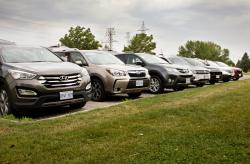 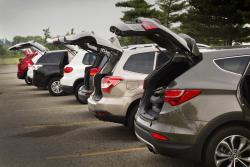 Compact Crossover SUV Comparison. Click image to enlarge |
Introduction, Jeff Wilson
Yes it’s true folks, the moment you’ve been waiting for: another Compact Crossover SUV Comparison Test!
You might be asking yourself, “Didn’t those whack-jobs at Autos.ca just do one of these last winter? And Autumn? And Spring?” and you’d be absolutely right. And while we’d much rather be doing comparison tests of muscle cars or exotic foreign machinery, the buying public keeps snapping up these pudgy little compacts-on-stilts, so we keep writing about them.
There’s plenty to say, too, since of the seven assembled entries, every one of them save the Honda and Volkswagen is either new or significantly reworked for 2013. Half of the group are 2014 models. We also aimed to cap the price at $35K MSRP, which brings new trim levels into the mix, and a price point at which many Canadian families actually shop for these vehicles. All but one managed to come in at our target price.
Honda’s CR-V is a multiple winner at Autos.ca due to its efficiency, practicality and value, so naturally it received an invitation. Likewise, Volkswagen’s Tiguan edged out the competition last year with a loaded up (and pricey) version of its tiny crossover. Volkswagen was asked to pare back and provide us with a more affordable Comfortline trim level to see if it can still wow our group. The kind folks at VW literally pulled the plastic wrap off our brand new test vehicle an hour before the competition began, and only then did we find out that it nudged slightly above our price window, but still not so far off that it was deemed necessary to exclude.
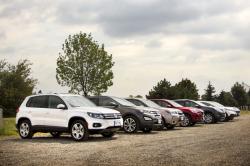 Compact Crossover SUVs. Click image to enlarge |
Hyundai’s Santa Fe Sport comes dressed in 2.0T SE AWD trim, which seems geared specifically for this shootout. With the lusty turbocharged engine and an impressive equipment list, Hyundai is looking to gain back the single point it lost in its last comparison against the Tiguan.
Mazda’s CX-5 was a near-winner in past comparison tests here, but was held back due to lacklustre handling attributed to little, squirmy snow tires and a weak-kneed efficiency-at-all-costs powertrain. Here a tarted-up GT model with 19-inch wheels and more sporting all-season tires should help rectify that complaint. And to ensure even greater competitiveness, Mazda has fitted the larger 2.5L SkyActiv engine from the fantastic new Mazda6 in the CX-5.
In either normally aspirated and turbocharged trim, Subaru’s all-new Forester has impressed Autos.ca’s writers this year, so we were understandably eager to pit it against the class best.
Toyota’s new-for-this-year RAV4 in XLE FWD trim battled hard against the CR-V in a head-to-head match this past spring but ultimately lost out. Here better equipped in Limited trim and yet still the second-lowest as-tested price, will its focus on value be enough to top the list?
Lastly, Mitsubishi’s all-new Outlander showed up to our business casual party wearing comfortable jeans and a T-shirt and keeping its price point to the lowest of the lot. Despite its value cost, the Mitsubishi is the only rig here to sport a V6 engine, but with ever-increasing fuel costs, will this prove a blessing or a curse?
The truth of the matter is, these are all very good machines that could serve well in small family duties The competition here is fierce and choosing a winner comes down to agonizing the details and sometimes heated discussion amongst the reviewers.
Here is what we found…
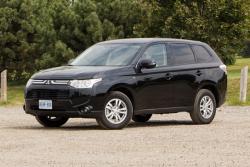 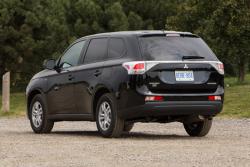 2014 Mitsubishi Outlander. Click image to enlarge |
7th Place: 2014 Mitsubishi Outlander, Steven Bochenek
It placed aggressively last for its looks – and last overall on the day, but wait! Don’t hang up just yet, there’s more to the story.
Remember Red Green’s popular saying, “If the women don’t find you handsome, they should at least find you handy”? It does well to describe the Outlander in this comparison.
When it comes to SUVs, I think they’re all ugly. They’re very useful for carting people and goods around; and just like many ugly people (myself included) they tend be good sports about it. Still, the Outlander won the booby prize for looks, rating just five out of 10 (top marks in this category: an eight for the CX-5).
However, the women will at least find it handy. And make no mistake: despite the rampant testosterone coursing through this site’s many pages, statistically it’s the woman of the home who makes the majority of auto-purchase decisions.
Furthermore, the SE AWC (stands for all-wheel control) trim that we had was by far the least expensive purchase of all seven vehicles.
And if she’s keen on the ‘Utility’ bit of SUV, the Outlander is worth a try (if not so much a look). Among this group, it alone seats seven. The fully collapsible back row is strictly for smaller children, but no other SUV in the pack had the option. Furthermore, the middle row was rated as seating three more comfortably than any of the others. These attributes helped the Outlander post the second highest score for Practicality/Flexibility. In short, utility.
If you like the ‘Sport’ part of the definition, there’s some good news here. The Outlander was one of only two SUVs that offered a paddle-shifting auto for the driver. Driving with the paddles produced a genuinely different feeling in the ride, decreasing the disconnected gulf between driver and road.
Plus, the Outlander was the only vehicle in the lineup with V6 power. It went fast and accelerated quickly. It gave good thrust on the test drive, especially on the straightaways, but our group far preferred the torquey turbocharged engines of the Santa Fe Sport and Forester XT.
Careful, though. In the bends the Outlander handled like… an SUV. Imagine driving a breadbox with air conditioning. Handling, like exterior looks, was one of the categories in which it placed dead last with a loud thud and plenty of space from the pack. However, it had a strong showing in the Comfort department, with two judges finding it the most comfortable.
Other deficiencies for the Outlander: Ease of Parking is no big surprise, given that the Outlander didn’t have a rearview camera. Likewise ‘Ease of driving’ is closely tied into handling and steering, where the Outlander tied for last.
And it makes sense that Interior Styling would score poorly if the Outlander made such a poor impression outside. Gauges and screens, too (in which it also trailed the pack), are so integral to interior styling – not even considering their impact on your entire experience.
As for goodies and extras, the Outlander’s price kept it from shining here. Unlike several competitors it didn’t include navigation, leather/leatherette seating, power liftgate or a sunroof. It did include heated seats and that V6 engine is worth a second mention.
But did it place first in any category? Just one, though it’s not insignificant: it got perfect marks for Warranty thanks to its aggressive 10-year/160,000 km Limited Powertrain Warranty on top of 5-year/100,000 km fully transferable bumper-to-bumper warranty and 5-year/unlimited km roadside assistance. Mix that with the price and practicality and it mitigates a good deal of those lasts. Handy.
Pricing: 2014 Mitsubishi Outlander SE AWC
Base Price: $30,998
Options: None
Destination: $1,450
AC Tax: $100
Price as tested: $32,548
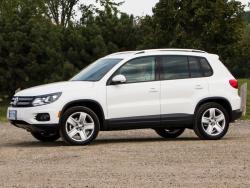 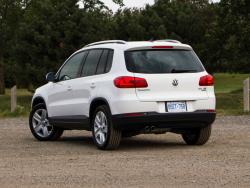 2013 Volkswagen Tiguan. Click image to enlarge |
6th place: 2014 Volkswagen Tiguan, Dan Heyman
At $37,640 MSRP, the Tiguan came in over our price cap by a couple grand, but as the defending champ and with VW Canada making every attempt to get us a trim in our price range, we owed it a chance to defend its title.
As the priciest of the group, you’d expect a healthy dose of tech for your dollar. Indeed, there’s a lot here: navigation, back-up camera, upgraded sound, satellite radio and leather seats complete the goodies inside, while nice alloy wheels and gorgeous LED DRLs complete the look outside.
It is a handsome car, the Tiguan; Editor Black says it’s hands-down the best-looking car of the group. While I may not agree completely, there’s very little to complain about, here, which is somewhat the consensus – it finished tied for third in this category.
Inside, the Tiguan treats front-seat passengers with a commanding view out, and an uncluttered dash that is ergonomic and well laid out, if not all that exciting to look at. The materials used, meanwhile, are of high quality. The seats seem supportive at first, but it finished fourth overall in front seat comfort, and Senior Editor Jonathan Yarkony noted some back fatigue after spending some time in it through the week.
Back seat passengers are subject to even more hardship.
Mainly, it’s about the space. The Tiguan may share platforms with the Golf, but I don’t think VW wanted us thinking “Golf” when we piled into the back seat, which is exactly what we did think. Two people? It’s tight, but comfortable for average-sized adults. Three? Forget it; if the middle passenger is any bigger than a child or family pet, their knees are going to be in their chest thanks to an intrusive centre console and driveshaft hump. This cost it dearly in the final rankings.
On the flip side, where the Golf underpinnings do shine is in the handling department. With the exception of maybe – maybe – the Mazda CX-5, nothing handled as directly and pointedly as this. Yes, the electric power-assisted steering may be down on feel, but that is only really an issue in a performance vehicle, not a crossover like this.
What is important in this application is ease of use in around-town and parking situations. Thanks to a short wheelbase, great outward visibility (it scored top marks in this category) and very little front or rear overhangs, the Vee-Dub is a joy in this environment. Ditto the noise, vibration and harshness (NVH) departments, where the Tiguan has you feeling coddled as you would in a much bigger SUV. VW ought to ease up a little in the suspension firmness department, however; repetitive bumps had the rear of the Tig bouncing like a pogo stick on certain occasions.
The powertrain doesn’t quite match up with the chassis, however. The Tiguan is available with only the Tiptronic automatic in AWD trim and it hampers acceleration to the point where it feels weaker than something like the Mazda, which has less power (184 to 200 hp in the Tiguan) but feels faster. You can have a six-speed manual, but only if you’re willing to make do with front-wheel drive.
The CX-5 has a naturally aspirated lump as opposed to a turbocharged unit like the Tiguan, so you’re dealing with turbo lag, too.
Because of these powertrain issues and the limited space and utility, not to mention a poor value quotient because of its high price, sixth was the best it could do in this company.
Pricing: 2014 Volkswagen Tiguan Comfortline 4Motion Tiptronic
Base Price: $33,640
Optional Equipment: Technology Package – $2,300; Sport Package – $1,700
Destination: $1,395
A/C Tax: $100
Price as Tested: $39,135
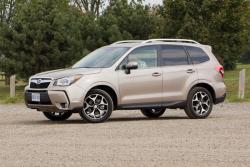 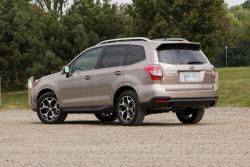 2014 Subaru Forester. Click image to enlarge |
5th Place: 2014 Subaru Forester, Steven Bochenek
If you’re in the market for a small to mid-sized SUV, you’ve probably noticed how competitive the segment is and how similar the products are. Consider: out of a possible 355 points, the final scores for four of the seven entries were spread by only 5 points, with the Forester falling almost exactly in the middle.
Out of 29 criteria, the Forester typically fell towards the middle, but here’s where it placed first: ease of front entry; rear-seat comfort for two passengers; engine; and, finally, transmission. The first two may seem insignificant unless you have a sore back and growing kids. If your children are still very small, chances are you’ll have a sore back soon enough.
For its engine, the Forester placed well ahead of all others: 2.0L 16-valve, twin-scroll turbocharged four-cylinder Subaru Boxer engine with direct injection. The Forester scored low on observed fuel economy but fortunately this exceptional engine runs on regular gasoline.
During our brief fling, I felt no turbo lag but plenty of liftoff. I distinctly remember a smile emerging as I descended, paddles a-working, into a tight turn onto Eglinton Avenue, foot heavy on the accelerator. It was my last ride of the day and the speed was exhilarating.
However, first impressions obviously count. There’s a lot to be said for the importance of design, even in a thuggish category like SUVs. Meaning? Just like the uglier children in school, statistically speaking (and from personal experience) the uglier cars seem to get judged harsher after failing to make a good first impression.
The Forester scored second-last for Interior Styling, while it scored near the top for Exterior Styling, though I differed in opinion from the group on this one. From my notes on the day: “Ugly outside, fairly good inside; quality of material was good – put together well.” (Not many people use semi-colons for taking notes.) Its overall score for quality inside was lower than mine, but the entire spread from first to last was very close – as we’ve established, by now.
I was impressed by how much of the Forester’s technology is available within reach of your thumbs when your hands are in the correct 9 and 3 o’clock positions.
And of course let’s not forget the paddles and Subaru’s aggressive S# driving mode, which you can shift into for a more thorough driving experience or simply tap for immediate control. (It’ll slip back to automatic, assuming you hit it accidentally or only wanted it temporarily.) Only one other SUV in the comparison, the Outlander, even offered paddles.
All this within your correct grip zone on the steering wheel seemed pretty cool to me. To others it may have seemed excessive, showing off buttons like some ‘80s ghetto blaster. That fiddly, small-buttoned stereo system brought its scores down in the Usability department, finishing only ahead of the Honda and its horrendous infotainment system.
You’d have every right to be curious as to why the Forester needs paddle shifters when equipped with a gearless CVT, but in S and S# modes, it simulates six and eight gears, respectively, and its operation was both seamless in regular mode and quick-shifting in either of the sport modes, enough to earn this transmission top marks (tied with CX-5). Doesn’t hurt that it also had the top-rated engine in the comparison.
(Another useful-to-know stat: the Forester placed second for its sightlines. With its included rear-view camera, you’re in a good place.)
Of course, in the name of fairness, here’s where the Forester placed last. It tied for Steering/Braking – both of which displayed some looseness and somewhat muddled feel. It also tied for last with three others on warranty.
Which leads to the ultimate question: is this good value for you?
Pricing: 2014 Subaru Forester XT Limited
Base Price: $35,495
Options: None
Destination: $1,650
AC Tax: $100
Price as tested: $37,145
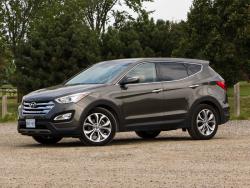 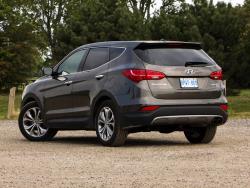 2013 Hyundai Santa Fe Sport. Click image to enlarge |
4th Place: 2013 Hyundai Santa Fe Sport, Michael Bettencourt
Now at the fourth place-finishing Hyundai Santa Fe Sport, we’re really getting into the thick of the contenders for sport-cute supremacy. Okay, so the Santa Fe didn’t quite make it onto the podium in this battle, and just eked out a place ahead of the Forester. But c’mon, the Subaru didn’t even come to this 35-grand family-friendly party with super handy proximity entry or a massive panoramic sunroof, all of which come standard on the SE 2.0T model Santa Fe tested here – and that’s not even the top-line model.
It wasn’t quite the hot looker of the group – take a bow, Ms. CX-5 – but the Hyundai came in a credible second to the Mazda in visual charm, for all that’s worth in this battle of the two-box crossover set. All are shaped practically, but the Hyundai doesn’t sacrifice cargo nor interior space for its zoomy looks, with top marks in cargo room, child-seat installation ease and three-across seat space. That swoopy rear window line that rises up dramatically and forms a point towards the rear spoiler looks cool, but it does hamper rear three-quarter visibility somewhat.
The warm styling vibes continue as you approach it, unlocking itself at the push of a button on the door handle, with your key still in your pocket. The Sante Fe’s interior nailed the highest score amongst these seven rivals for its interior looks, the standard leather seats of the SE and Limited combining well with classic touches such as the warm if subtle wood-like trim, while the feature-filled steering wheel also complemented the funky cobra-about-to-strike shape of the center instrument panel.
Large buttons are easy to see and manipulate, cupholders right where they should be, and a large centre armrest that’s helpful to stay comfortable on long drives allows one’s right elbow to rest while hands are still on the wheel. It managed a credible second place in terms of overall driver comfort, coming in second only to the Honda CR-V and its minivan-like and oh-so-comfy fold-down armrests.
The Hyundai also topped rear seat comfort for three, and banged off another first in the tricky ‘Ease of Rear Entry’ category. Strangely, it finished tied for second last in rear seat comfort for two, suggesting that it’s a close call back there amongst all but our consensus tightest (and priciest) of the bunch, the VW Tiguan.
Speaking of value, the Santa Fe was a strong contender here, as usual with Korean products these days, but didn’t wow as much as some of the others. All of the top four finished with as-tested MSRPs right around $35,000 (before freight and taxes), give or take the price of a decent 32-inch flat screen TV. It placed second in value, offering not only the common rear camera, leather, and heated seats niceties, but unexpected luxuries like a heated steering wheel, sun blinds to give the kiddies in the back some shade, and rear heated seats, for when those kiddies grow out of their booster seats (happens so fast, sniff sniff…).
It also did well on the performance front, battling the Subaru for turbocharged grunt champion. The Santa Fe’s 2.0L turbocharged engine puts out a stout 264 hp and a stouter 269 lb-ft of torque, both the highest in this group. And it felt much more stable in the corners than the Forester, and even in a straight line, with little of the Subaru’s dive and squat that makes it feel positively floppy in comparison.
Unfortunately for Hyundai, the navi system reserved for top-line Limited Santa Fe models were present and accounted for on others here. But what really booted the swift, turbocharged Korean off the podium was its fuel economy, in both EPA measurements as well as those observed after a day’s driving of each vehicle nearly nose to tail, on the same route, encompassing city and highway driving on varying pavement types. Its EPA average of 11.2 L/100 km was markedly thirstier than the two Canada-built podium finishers that tied at 9.4 L/100 km averages, while the Santa Fe’s less scientific observed number came in at 14.5 L/100 km, well off the standard set by the eventual winner.
Pricing: 2013 Hyundai Santa Fe Sport 2.0T SE
Base Price: $35,299
Options: None
Destination: $1,760
AC Tax: $100
Price as tested: $37,159
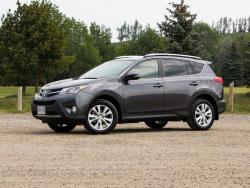 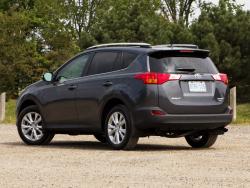 2013 Toyota RAV4. Click image to enlarge |
3rd Place: 2013 Toyota RAV4, Lesley Wimbush
I have to admit, this vehicle surprised me. I’d anticipated spending a few days in a sensible econobox, but ended up appreciating the RAV4 for how hard it works to make your life easier.
Although Mazda’s spunky little CX-5 won my top vote for its engaging performance, the RAV4 is one that I wouldn’t hesitate to recommend, particularly to those who value practicality and function over sparkling character.
Once a chunky little box that was the embodiment of economy, the new RAV4 has evolved into a svelte and sophisticated crossover. I’d go so far as to say that this is a good-looking vehicle – with none of the cartoonish exaggeration of the CX-5.
Pleasant surprise number one: Opening the door at a ridiculously early hour in order to make it to the comparo on time… I’m a bit startled that the interior of the RAV4 is not just acceptable, but really nice. It’s stylish, and while it’s not going to cause Audi to lose any sleep, there’s nothing about the materials or design that screams “on a budget” and earned it podium ratings in Interior Styling and Quality.
The two-tiered dash is finished in stitched leather-look materials and there are several well thought out nooks for sunglasses, phone and such.
The centre stack is logical and well laid out, although a second row of buttons above the cupholder are difficult to see. Although the shifter panel is plastic, it’s got an interesting, carbon-fibre texture to it that’s repeated on the door panels. Steering wheel is “leather” wrapped and features thumb indentations to encourage proper hand position.
Pleasant surprise number two: It’s the seats that really woke me up and took me by surprise. They’re terrific – well bolstered and comfortable, these are the kind of chairs you’d expect in a sports car – in fact almost every participant in our comparo commented on them. The RAV4 received top marks in test for Driver Seat comfort and position.
When it comes to driving dynamics, it’s no surprise that the Mazda trumps the Toyota – after all, this is the company that coined “zoom-zoom”, but the RAV4 again pulled out podium results in Handling and Steering/Braking Feel – a far cry from the sloppiness of the previous generation.
The RAV4’s single engine choice is now a 2.5L four-cylinder with 176 hp and 172 lb-ft output. It’s more than adequate for this size of vehicle, and the driver can choose between Eco mode, which is more fuel conservative, or Sport, which is a lot more fun. It does tend to drone a bit when pushed hard. The new six-speed automatic transmission executes shifts cleanly and smoothly and offers marked efficiency improvements in place of the previous four.
Another area in which it shines is with Practicality and Flexibility. Transporting a borrowed lawnmower, I simply pulled up a lever, and the rear seats dropped down, perfectly flat. The automatically powered liftgate was greatly appreciated too.
Overall, this is a really well-planned, easy-to-live-with vehicle, with an undeniable value – it placed first in Features/Amenities thanks to the long list of equipment in the Technology Package, which also helped it edge out the Santa Fe and CX-5 in Value. However, in too many categories, the RAV4 was just a shade behind our top finishers, but it proved itself to us as an eminently capable crossover.
Pricing: 2013 Toyota RAV4 AWD Limited
Base Price: $31,700
Options: Technology Package (Voice recognition, Premium JBL Audio, satellite radio, 11 speakers, lane departure alert, blind spot monitor, rear cross-traffic alert, back-up sensors) – $3,135
Destination: $1,635
AC Tax: $100
Price as tested: $36,570
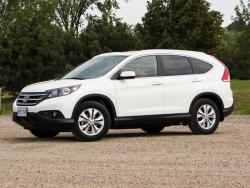 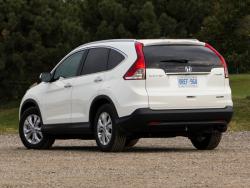 2013 Honda CR-V. Click image to enlarge |
2nd Place: 2013 Honda CR-V, Jacob Black
That the Honda CR-V came in second will probably surprise some people – they might expect it to come first. After all, it has in the past. Besides, Honda has been doing this dance for a fair while now and the CR-V rivals the RAV4 for its genre-creating CUV pedigree.
The cabin storage is amazing, and the one-touch lever to fold the rear seats makes this the easiest cargo space of all our testers – including the Outlander with its third seating row. The fact you can put two bags of shopping (or a six-pack of beer) in the centre console is one of those, “oh my God why don’t all cars have this?” features. Little surprise then that the CR-V dropped a piano on the competition in the “Interior Storage” category.
But even that can’t overcome the disaster that is the CR-V’s human machine interface. The fact is, CUVs are about convenience. Easy entry and exit, easy dumping shopping, easy installing thrashing toddlers into chairs.
The Honda wins big points on all those, but suffers an almighty fail in the stereo/navigation interface department. Little, fiddly buttons, the single-worst voice recognition system in living memory and the poorly arrayed displays make the CR-V just too difficult to live with.
The green trim around the centre dash dial is pretty, and adds a touch of interest to a cabin that is otherwise reminiscent of a Jackson Pollock in an argument with a Pro-Hart. Half the points the CR-V gave up to the CX-5 came from the Gauges/Info Screens, Stereo, and Features categories.
The rest? From the powertrain. The 185 hp/163 lb-ft, 2.4L DOHC engine just didn’t have the verve of the Mazda’s. The transmission gave up one cog to the Mazda tranny too, and that was too much of a gap for the otherwise-wonderful and smooth-operating Honda to make up.
While easy to drive and incredibly comfortable (first in Comfort), the Honda suffered from a lack of sharpness behind the wheel. The Mazda just had a keener edge to it without being a whole lot less comfortable.
In terms of exterior styling I think the CR-V is good enough, but then I was the only one of our group who thought the Mazda was anything other than a Mona Lisa.
The front bumper disappears into the underside of the car with a steep rake, while the front grille eats into the headlight housings. The whole effect is one of a middle-age man grinning mischievously. The rear taillights dripping down the sides of the rear windscreen make the back end one of the most interesting in the class. Overall, the Honda had a lot more character than you might expect. If it wasn’t for its bland wheels, I think the CR-V would have pipped the Forester in the looks department.
As it was, the Honda tied with the RAV4 in second-last, beaten by the gorgeous Tiguan, the “hot wheels, ugly car” Forester, the Franken-grille Santa Fe and the “adored by everyone but me” Mazda. Only the “what on earth is that?” Outlander was scored lower. Beauty is in the eye of the beholder I guess.
Regardless of that, the Honda CR-V did what the Honda CR-V has always done in our comparison tests; impressed the pants off us. It performed solidly in almost every category, and ultimately lost simply because the Mazda did the same, only sans “almost”.
Pricing: 2013 Honda CR-V Touring
Base Price: $35,215
Freight and PDI: $1,695
A/C Tax: $100
Price as Tested: $37,010
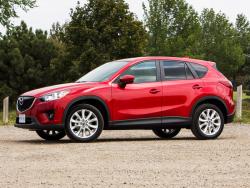 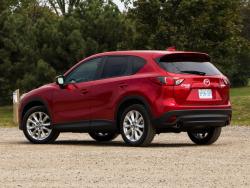 2014 Mazda CX-5. Click image to enlarge |
1st Place: 2014 Mazda CX-5, Jeff Wilson
The numbers don’t lie. In what can only be described as a complete and utter domination of this comparison test, Mazda’s CX-5 amassed nearly ten more points than the second place Honda, and was the overall winner for six of our seven reviewers.
The funny thing is, I’m not sure many of us (save for Senior Editor Yarkony who was quick to point out “I called it!”) realized it was the winner immediately following our back-to-back drives. The Forester’s lusty engine and the Tiguan’s fun-to-drive handling leave positive first impressions. Likewise, the RAV4’s impressive equipment list and the Santa Fe’s feeling of luxury resonated with most of our testers. But it’s the Mazda’s consistently solid performance across every criteria that helped it secure its victory (the only notable sore spot being its tied-for-last-place showing in Ease of Entry Front).
None of the crossovers in this test will ever stop traffic for their arresting good looks the way a low and mean sports car does, but the handsome little ute speaks well of Mazda’s new Kodo design language. Its fluid lines, big, sporty-looking wheels and hot red paint make it a refreshing standout amidst the assembly of earthy shades of taupe, grey and white, and often awkward styling.
The CX-5’s interior layout features stylistic treatments reminiscent of the new Mazda6 with high-gloss trim pieces and easy-to-use rotary knobs for climate control. Likewise the large, round gauges that wouldn’t be out of place in an MX-5 roadster are highly legible. It’s the precision build quality and assembly that help the Mazda’s interior stand out amongst an admittedly very refined field. The Mazda beat out the competition for Exterior Styling, then brought it home with Quality (fit/finish) and Gauges/Info Screens.
However, the Mazda’s interior does not provide the same wealth of storage spaces found in the CR-V, nor are the passenger or luggage accommodations as commodious as the Santa Fe, but neither is it the smallest in the group.
The CX-5’s consistently high scores throughout the test speak to a sensible balance in the way it goes about its business. Not the largest, but not the smallest. Not the most powerful, but not the weakest. Most impressive is the balance between handling prowess and ride comfort.
The CX-5 nips at the lively Tiguan’s heels in terms of steering feel, brakes and handling, but where the Volkswagen trades its handling prowess for an abysmal ride, the nimble Mazda is nearly as compliant as the comfy Honda. How’s that for balance? Clearly the missteps of our previous CX-5 tester shod with mediocre snow tires are forgiven and forgotten with this GT model’s 19-inch wheel and all-season tire set up.
But there’s more. Its middle-of-the-pack dimensions and good sightlines ensure it’s easy to feel comfortable driving and parking without needing to depend on a back-up camera (which it still has).
The new 2.5L Skyactiv no longer feels underpowered the way the 2.0L did. Still quick to rev, the larger mill is well matched to the top-rated six-speed automatic with its swift and precise shifts. Most remarkably, this power plant provides no penalty in fuel consumption, netting top rankings for both our observed economy (11.0 L/100 km) and the EPA Combined rating (9.0 L/100 km), a more reasonable expectation of real-world fuel economy than our high consumption ratings on test day. Trust us, Mazda’s brilliant Skyactiv technology is no gimmick.
Perhaps most importantly, though, our CX-5 GT represents a solid value amongst its peers. With a decent feature and amenity list (Jacob Black was particularly excited by the voice-to-text function) combined with honest driving enjoyment, a stylish appearance and solid build quality, we have no choice but to award this Mazda the decisive victory amongst this latest group of extremely competitive cute-ute combatants.
Pricing: 2014 Mazda CX-5 GT
Base Price: $33,250
Options: Technology Package (Smart City Brake Support (SCBS), Bi-Xenon headlights, Adaptive Front Lighting System, Auto headlamp levelling, Navigation system, SiriusXM Satellite Radio) – $1,795; Soul Red Mica paint – $300
A/C Tax: $100
Destination: $1,895
Price as tested: $37,340















































































































